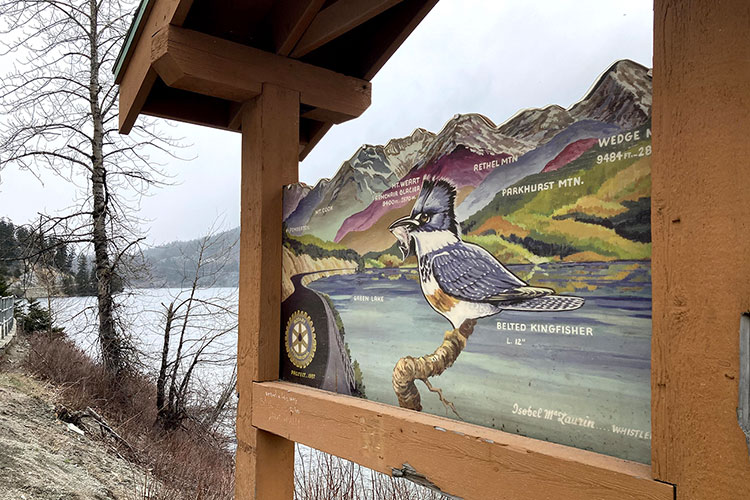The long sun-soaked days of summer are upon us and with them comes the opportunity to get away for a much-deserved vacation. If you’ve visited Whistler before it can be easy to think that you have seen it all, but locals know the forests, mountains and rivers are slow to give up their secrets. You could spend decades here and still have a long list of places you have yet to explore.
Make this the year that you adventure deeper and venture off the beaten path. With a little extra effort and some local intel, you can discover new spaces (with fewer faces) that will have you falling even deeper in love with Whistler.

Waterfalls
Basically, anyone that has driven from Vancouver to Whistler has made the standard waterfall sightseeing stops – Shannon Falls, Brandywine Falls and Nairn Falls. These spots are classics, and for good reason, they’re absolutely gorgeous. However, here are a couple more you might not have been to yet to add to your list.
Alexander Falls
A thirty-minute drive south of Whistler Village, you can find one of the most accessible and striking waterfalls in the area, Alexander Falls. Look for signage along the Sea to Sky Highway towards Whistler Olympic Park and turn onto Callaghan Road. Drive 10 kilometres to the Alexander Falls parking lot, which is on the left before you cross a small bridge into Whistler Olympic Park. From the parking lot, the lookout is just a few short steps away.
Beyond its beauty, a feature that sets this spot apart is its ease of accessibility. I regularly suggest Alexander Falls to any visiting friends or family that may have mobility issues or small children. While you’re there you can spend time admiring the falls from the lookout platform and then savour a picnic lunch at one of the tables on site.
The Callaghan Valley is a great place to spot bears, and the safest and most rewarding way to view them is on a bear viewing tour with an expert guide who can tell you all about them. Whistler sightseeing tours also go out this way, along with stopping off at other hot sightseeing spots in Whistler. Another way to visit the falls is to do it via e-bike, read more about that experience with Canadian Wilderness Adventures in Whistler E-Bike Tour: The Great Canadian Adventure.
Rainbow Falls
A hike to a majestic waterfall doesn’t have to be a big commitment. If you have a spare hour, check out the hike to Rainbow Falls. Starting from the trailhead for Rainbow Hike on Alta Lake Road, hike uphill taking the first fork off the main trail to the right towards the falls. If you reach the water treatment plant you have gone a little too far.
The hike is 1.4 kilometres round trip with an elevation gain of 68 metres. I have hiked it many times carrying a toddler and it’s manageable for small children; just be sure to allow extra time for rest stops.
There is limited parking at the trailhead and the hike is popular so consider going midweek or getting there via bike on the Whistler Valley Trail (you can lock them to a tree at the bottom).
INSIDER TIP: For more inspiration and information on our local waterfalls read, A Guide to Sea to Sky Waterfalls.
Elemental Exploration
Whistler and the Coast Mountain Range have a very interesting geological history. Shaped by colliding tectonic plates and volcanic eruptions; long after the molten lava cooled it left a legacy of insanely cool geological formations.
There are some areas around Whistler that look like Mother Nature employed a paver to do a bit of work. The hexagonal basalt columns were naturally formed though when volcanic lava cooled in a certain way forming these pillar-like structures. The Giant’s Causeway in Northern Ireland was formed in the same way, we still have to come up with our own giant-filled legend though.
Whistler is in the early phases of establishing a UNESCO Global GeoPark. Much the same as how Provincial Parks are created to recognize, share and protect significant natural spaces, a geopark does the same for sites of international geological significance. The sites included below are slated to be part of this project.
Crater Rim & Loggers Lake
Have you ever wanted to swim in an extinct volcano? It sounds unbelievable, but Loggers Lake is indeed the water-filled bowl of a long-extinct volcano. Cool right? The hillside around the lake is covered in basalt columns and large pieces that have broken off over time. The Crater Rim hike will take you on a loop around the lake with elevated views of the lake and valley as you go.
 The trailhead is on the corner of Mount Fee Road and Cloudburst Drive in Cheakamus Crossing. As it’s conveniently located right beside a bus stop for routes 10 and 20 from Whistler Village, getting there by bus is the easiest way to access this hike. If you absolutely must drive, there is a lot in the Whistler Interpretive Forest on the corner of Cheakamus Lake Road and the Sea to Sky Highway. The parking is free, but space is limited.
The trailhead is on the corner of Mount Fee Road and Cloudburst Drive in Cheakamus Crossing. As it’s conveniently located right beside a bus stop for routes 10 and 20 from Whistler Village, getting there by bus is the easiest way to access this hike. If you absolutely must drive, there is a lot in the Whistler Interpretive Forest on the corner of Cheakamus Lake Road and the Sea to Sky Highway. The parking is free, but space is limited.

Sugarcube Hill
You are probably very familiar with the Sea to Sky Highway, but did you know that there is also the Sea to Sky Trail connecting Squamish to Whistler? Attempting the whole trail is a big ask, but exploring small sections at a time is a fantastic way to discover new hidden gems in the area.
 One of my absolute favourite sections of the Sea to Sky Trail is between Cheakamus Crossing and Brandywine Falls. The route includes rolling forest trails, lookouts, a bridge crossing over icy blue water, and the weird and wonderful Sugarcube Hill.
One of my absolute favourite sections of the Sea to Sky Trail is between Cheakamus Crossing and Brandywine Falls. The route includes rolling forest trails, lookouts, a bridge crossing over icy blue water, and the weird and wonderful Sugarcube Hill.
If like me you’re not exceptionally fit you will enjoy this route best by bike. From the Train Wreck Hike parking lot on Jane Lakes Road, cross the road onto the Sea to Sky Trail. Be sure to travel slowly for the first part of this trail as it’s also the route to Train Wreck, which is popular with hikers and dog walkers. For a speedier alternate route, you can bike down the Jane Lakes Logging Road. Once you’re further down the road there are points where the Sea to Sky Trail is accessible to rejoin.
After four kilometres you will reach a bridge crossing the Cheakamus River. From there travel another two kilometres further down the trail and you will find Sugarcube Hill. It’s a little tucked away on the side of the trail, so keep your eyes peeled after you exit the forest onto the sunny open section of trail.
 You can stop there for a drink, or picnic before biking back the way you came, or continue on to Brandywine Falls for more scenic spot action.
You can stop there for a drink, or picnic before biking back the way you came, or continue on to Brandywine Falls for more scenic spot action.
Whistler is still the same fun-loving, thrill-seeking destination it’s always been, we’re just slowing the pace a touch this summer. We can’t wait to welcome you back when the time is right and if you want to win a trip to Whistler this summer (enter now, travel later), check out the Adventure Deeper Contest, which includes round-trip airfare, six nights’ accommodation and a host of summer activity fun.
This summer, the longer you stay, the more you save with room rates dropping as you book more nights (7 nights from $93 CAD per night). You will also receive a free adventure voucher, which gets you up to $100 off a Whistler activity.

